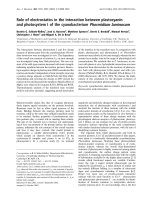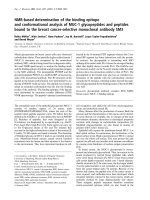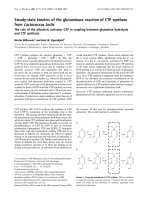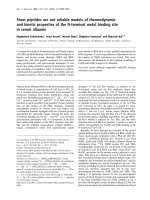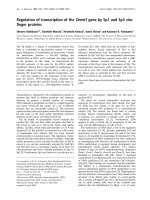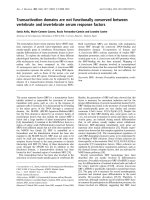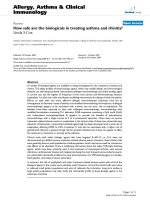Báo cáo y học: "PARP-1 inhibitors: are they the long-sought genetically specific drugs for BRCA1/2-associated breast cancers"
Bạn đang xem bản rút gọn của tài liệu. Xem và tải ngay bản đầy đủ của tài liệu tại đây (311.85 KB, 7 trang )
Int. J. Med. Sci. 2006, 3
117
International Journal of Medical Sciences
ISSN 1449-1907 www.medsci.org 2006 3(4):117-123
©2006 Ivyspring International Publisher. All rights reserved
Review
PARP-1 inhibitors: are they the long-sought genetically specific drugs for
BRCA1/2-associated breast cancers?
Joseph A. De Soto and Chu-Xia Deng
Genetics of Development and Diseases Branch, National Institute of Diabetes and Digestive and Kidney Diseases, National
Institutes of Health, 10/9N105, 10 Center Drive, Bethesda, MD 20892, USA.
Correspondence to: Dr. Chu-Xia Deng, Phone: (301) 402-7225, Fax: (301) 480-1135. Email:
Received: 2006.06.06; Accepted: 2006.07.12; Published: 2006.07.15
Recent studies demonstrated that PARP-1 [poly(ADP-ribose) polymerase-1] inhibitors kill breast cancer
associated gene-1 and –2 (BRCA1/2) deficient cells with extremely high efficiency while BRCA+/- and
BRCA+/+ cells are relatively non-responsive to the treatment. It was therefore proposed that PARP-1 inhibitors
might be the long-sought genetically specific drugs that are both safe and effective for treating BRCA1/2-
associated breast cancers. However, a report published in a recent issue of the International Journal of Biological
Sciences revealed that PARP-1 inhibitors, although able to kill naïve BRCA1 mutant cells with high specificity
both in vitro and in vivo, exhibit minimal specificity in inhibiting the growth of mouse mammary tumor cells
irrespective of their BRCA1 status in allograft nude mice. Non-specific inhibition in human BRCA1+/+,
BRCA1+/-, and BRCA1-/- breast cancer cells by PARP-1 inhibitors was also observed. Additional mutations
occurring during cancer progression may be a culprit, although the exact cause for the resistance of BRCA1-/-
breast cancer cells to PARP-1 inhibitors remains elusive. These findings suggest that PARP inhibition may serve
as an approach for the prevention of BRCA related breast cancer and may be useful in combination with other
chemotherapeutic agents in the treatment of breast cancer.
Key words: PARP inhibitors, BRCA1, breast cancer, therapeutic treatment, AG14361
1. Introduction
Breast cancer is the leading cause of cancer
incidence and the second leading cause of cancer
mortality in women. Familial breast cancer is a small
subset of this disease contributing to about 5 to 10% of
breast cancer cases. Germline mutations of the breast
tumor suppressor genes BRCA1 and BRCA2 have been
found to contribute to most of the familial breast
cancer cases [1-5]. BRCA1 was mapped in 1990 [6] and
cloned in 1994 [7]. Numerous studies in the past
decade have revealed that BRCA1-deficiency results
in genetic instability, primarily due to centrosome
amplification, defective cell cycle checkpoint, and
impaired DNA damage repair (reviewed in [8-15]).
Hence, BRCA1 is essential for maintaining genome
integrity while genetic instability associated with
BRCA1 deficiency is responsible for breast cancer
formation [16, 17].
One of the major causes of the genetic instability
associated with BRCA1 deficiency is that BRCA1
mutant cells have an impaired ability to undergo
homologous recombination (HR) [12, 14, 18-20], and
therefore cannot effectively repair HR-mediated DNA
damage, such as DNA double strand breaks (DSBs). In
the absence of BRCA1, DSBs can be gradually
accumulated, which may result in the activation of
oncogenes and inactivation of tumor suppressor genes,
eventually leading to tumor formation. On the other
hand, defective DNA damage repair may also make
BRCA1 deficient cancer cells more sensitive to DNA
damaging agents, such as irradiation, Mitomycin C
(MMC), and adriamycin [19, 21-23]. Thus, one of the
therapeutic approaches to kill BRCA1 deficient cancer
cells efficiently is treating these cells with DNA
damaging reagents thereby introducing acute DNA
damage. However, the majority DNA damage
reagents are not specific and can cause the similar
extent of damage in both BRCA1 mutant and wild
type cells. More recently it was shown that PARP-1
inhibitors could kill BRCA1/2 deficient cells with high
specificity bringing great promise to the BRCA1
cancer patient [24, 25]. Here we will review the current
progress of PARP-1 inhibitors in the chemoprevention
and therapeutic treatment of BRCA1/2-associated
breast cancers and discuss possible options for using
these drugs efficiently.
2. PARP-1 inhibitors as potential
chemotherapeutic drugs
Using a clonogenic survival assay, Bryant et al.
(2005) found that a BRCA2-deficient cell line V-C8,
compared with the BRCA2 wild type control,
exhibited extreme sensitivity to AG14361, a very
potent PARP-1 inhibitor (K
I
=5nM), and NU1025, a
moderately potent PARP-1 inhibitor (K
I
=50nM).
NU1025 treatment also profoundly reduced colony
formation (up to 100 fold) of MCF-7 and MDA-MB-
231 cells when BRCA2 was depleted by RNAi
compared with untreated control cells [24]. Studying
Int. J. Med. Sci. 2006, 3
118
mouse embryonic stem (ES) cells carrying targeted
mutations of BRCA1 (homozygous deletion of exons
22-24, referred to as BRCA1-/-) or BRCA2
(trEx11/ΔEx27, referred to as BRCA2-/-), Farmer et al.
(2005) revealed similar sensitivity of these cells to
PARP-1 inhibitors in vitro [25].
Will this work in vivo? To investigate this, both
groups transplanted BRCA2-deficient ES cells [25] or
V-C8 cells [24] into athymic nude mice and treated the
xenografted tumors with PARP-1 inhibitors. Their
data revealed that PARP-1 inhibition completely
blocked the growth of BRCA2-deficient tumors, but it
had no effect on BRCA2-wild type tumors. It was
subsequently suggested that PARP-1 inhibition might
represent a new concept in cancer treatment for
BRCA1/2 mutation carriers.
Why are BRCA1- and BRCA2-deficient cells
extremely sensitive to PARP-1 inhibition? The
products of the genes, BRCA1, BRCA2 and PARP-1,
are nuclear proteins and are critical components of the
cellular response to DNA damage [12, 14, 18-20, 26-28].
PARP-1 binds to and efficiently repairs DNA single
strand breaks (SSBs) formed during base excision
repair (BER) of small DNA adducts induced by
alkylating agents or ionizing radiation [29]. It has been
shown that PARP-1 inhibition leads to persistent
single strand breaks (SSBs) in DNA [27], which result
in formation of double strand breaks (DSBs) when
they meet at replication forks (Fig. 1A). In the presence
of wild type BRCA1 and BRCA2, DSBs can be
efficiently repaired by RAD51 mediated homologous
recombination (Fig. 1B). It has been shown that
BRCA1 and BRCA2 interact with RAD51, and play
essential role in homologous recombination [28, 30,
31]. Thus, in the event of DNA damage associated
with PARP inhibition, BRCA1 or BRCA2 mutant cells
cannot repair DNA DSBs properly, leading to the
collapse of replication forks, and illegitimated DNA
ends joining, consequently leading to growth arrest
and apoptosis (Fig. 1C). This model provides a
molecular basis for the reason that why BRCA1- and
BRCA2-deficient cells are extremely sensitive to
PARP-1 inhibition.
Figure 1. A model showing DSB formation and DNA rearrangement in the absence of BRCA and PARP1. (A) PARP-1
binds and repairs single strand breaks (SSBs) in DNA. These SSBs result in formation of double strand breaks (DSBs) when
they meet replication forks. (B) In the presence of wild type BRCA1 and BRCA2, DSBs can be efficiently repaired by
RAD51 mediated homologous recombination (HR). (C) BRCA1 or BRCA2 mutant cells cannot repair DNA DSBs properly
upon the inhibition of PARP, leading to DNA replication arrest and illegitimated DNA ends joining.
3. Can PARP-1 inhibitors specifically kill human BRCA2-deficient pancreatic cancer cells?
Because PARP-1-null mice are viable and healthy [32], and inhibitors that are specific for PARP-1 are
relatively non-toxic and do not directly damage DNA, PARP-1 inhibitors might be both safe and effective for
BRCA1/2-associated breast cancers. However, it is noticed that these data were obtained by using non-
cancerous and genetically naïve BRCA1/2-/- ES cells, BRCA2-/- V-C8 hamster cells, and two BRCA2-proficient
breast cancer cell lines, MCF-7 and MDA-MB-231, that carried acute suppression of BRCA2 by siRNA. Cancer
cells originated from naturally occurring BRCA1/2 mutations were not tested. To investigate this, Gallmeier and
Kern (2005) treated a cell line CAPAN1, which harbors the frequent, naturally occurring BRCA2 6174delT
frameshift mutation accompanied by loss of the second allele with NU1025 and 3-aminobenzamide (3AB), a
weak PARP-1 inhibitor with the K
I
=500nM [33]. Their data indicated that PARP inhibition by these drugs did
not result in significant cell death of CAPAN1 cells. This observation casts doubt about the uniformity of the
specific cell killing of BRCA2-deficient cells upon PARP inhibition. This observation also urged caution as to
whether prior findings were fully generalizable for the specific treatment of human cancers harboring naturally
occurring, inactivating forms of BRCA2 mutations.
Int. J. Med. Sci. 2006, 3
119
The finding that CAPAN1 cells are relatively insensitive to NU1025 was quickly confirmed [34]. McCabe et
al. (2005) compared sensitivity of the CAPAN1 cells to 4 PARP inhibitors, including NU1025, KU0051529 (a
weak PARP inhibitor, IC50 730 nM) and two very potent PARP inhibitors, KU0058684 (IC50 3.2 nM) and
KU0058948 (IC50 3.4 nM). Their data showed that the CAPAN1 cells were indeed extremely sensitive to the two
potent PARP inhibitors although they were much less sensitivity to NU1025 and KU0058948. These results
indicate that treatment with potent PARP inhibitors might still be an exciting potential therapy for cancers
involving BRCA2 deficiency [34].
However, the puzzle has not been fully solved. NU1025 was previously reported to kill BRCA2-depleted
MCF-7 and MDA-MB-231 cells with extremely high efficiency, i.e. 100-fold reduction in colony formation at
about 10 μM of NU1025 [24]. In contrast, in CAPAN1 cells, this dose of NU1025 [34] and even at much higher
concentrations up to 200 μM [33] failed to exhibit any specific killing. While the reason for this discrepancy
remains unclear, it was proposed that genetic alterations during tumor progression due to genetic instability
associated with BRCA1- and BRCA2-deficiency might be a culprit [33]. In other words, some specific mutations
might block the sensitivity of BRCA1/2-/- cancer cells to PARP-1 inhibition.
Consistent with this, it was shown recently that the chicken DT40 PARP-1-/- mutant cells displayed
reduced levels of homologous recombination (HR) and were sensitive to various double strand break (DSB)-
inducing genotoxic agents [35]. Interestingly, when either Ku-70 or Ligase IV was also mutated, the PARP-1-/-
cells became resistant to the killing by DSB-inducing drugs. The underlying mechanism is that the absence of
Ku70 or ligase IV prevents illegitimated DNA ends ligation of DNA fragments by non-homologous mediated
end joining (NHEJ) in PARP-1-/- cells, therefore, preventing their lethality (Fig. 2). This study provides an
example that lethality associated with DSBs and PARP-1 inhibition could indeed be rescued by specific types of
mutations.
Figure 2. A model showing how Ku70 or ligase IV deficiency represses lethality caused by DSB inducing agents in PARP-
1-/- DT40 cells. (A) Treatment of DSB inducing agents in PARP-1-/- DT40 cells decreases ability of HR (HR*) and causes
DSBs. (B) Ku-70 protein competes with HR machinery and binds to DSBs, directing the repair toward the non-homologous
end joining (NHEJ), where ligase IV (LIG4) also plays an important role. This results in lethality of PARP-1-/- cells. (C)
The absence of Ku70 or Ligase IV prevents illegitimated DNA end ligation of DSBs through NHEJ in PARP-1-/- cells. This
allows more time for PARP-1 deficient cells to repair DSBs, therefore, preventing their lethality.
4. Can PARP-1 inhibitors specifically kill BRCA1 mutant breast cancer cells?
These observations cast significant doubts on the effectiveness and specificity of PARP inhibition on BRCA
associated tumorigenesis. Furthermore, previous in vivo studies only tested two cell lines, BRCA2 mutant ES
cells and C-V8 cells while BRCA1 mutant breast cancer cells were not used. To provide a study with more
clinical relevance, we compared sensitivity to PARP inhibition of 12 cell lines, including ES cells, mouse
mammary tumor cells, and human breast cancer cells using three PARP inhibitors: AG14361, NU1025, and 3-
aminobenzamide (3AB) [36].
We first tested a BRCA1 mutant ES cell line [BRCA1
trEx11/
Δ
11
that carries one BRCA1 mutant allele truncated
at exon 11 [37] and one allele with a deletion of exon 11 by a Cre-LoxP approach [38], referred to as BRCA1-/-].
Our data revealed that the BRCA1-/- cells were significantly more sensitive to AG14361 treatment than
BRCA1+/- and BRCA1+/+ ES cells both in vitro and in vivo. Indeed, AG14361 treatment completely blocked
tumor growth in 90% nude mice that had received transplantation of BRCA1-/- ES cells. Only one tumor that
escaped PARP inhibition grew, though much slower compared with tumors developed in the nude mice that
had received transplanted BRCA1+/+ ES cells. Next, we tested sensitivity to PARP inhibition using three
mammary tumor cell lines that are either hypomorphic (BRCA1
Δ
11/
Δ
11
) or null (BRCA1
-/-
) for BRCA1. In the
colonogenic assay, we found that all BRCA1-/- cell lines were much more sensitive to the potent PARP inhibitor
Int. J. Med. Sci. 2006, 3
120
AG14361 than BRCA1+/+ tumor cells (Fig. 3A). However, AG14361 treatment exhibited only mild specificity in
mouse BRCA1-/- mammary cancer cells (Fig. 3B) in comparison with their controls (Fig. 3C) in the xenografted
nude mice. These observations indicated that BRCA1-/- mammary cancer cells are indeed much more resistant
to PARP inhibition than BRCA1-/- ES cells in the allograft model. Finally, we studied response to PARP-
inhibition of four human breast cancer cell lines: MCF-7 (BRCA1+/+), MDA-MB-231 (BRCA1+/-), HCC1937
(BRCA1-/-) and SUM1315MO2 (BRCA1-/-). Using both clonogenic survival assay and MTT assay, we found
that PARP-1 inhibitors seem to have a similar inhibition effects on their growth regardless of the BRCA1
genotypes (Fig. 3D) [36].
We believe that the non-cancerous cells are generally naïve, whereas tumor cells represent cells that have
had multiple genetic mutations and that in a tumor there may be numerous fundamentally different cancer cells
when classified by the type and frequency of individual genomic changes. It has been shown that tumorigenesis
involves alterations of at least 6 major biological pathways/processes [39]. Indeed, our work in BRCA1 mutant
mouse models have also revealed numerous genetic/molecular alterations in BRCA1 mutant tumors, and have
demonstrated that BRCA1-associated tumorigenesis has been selected to survive genomic changes [21, 22, 38,
40-43]. This may account for the differential resistance to PARP inhibition observed between BRCA mutant
cancer cells and pre-cancerous cells [36].
Figure 3. Effect of a potent PARP-1 inhibitor, AG14361, on BRCA1 mutant and control cancer cells. (A) Clonogenic
survival assay. Five hundred 780 (BRCA1Δ11/Δ11), and 525 (BRCA1-/-), and NEU (BRCA1+/+) cells were exposed to
AG14361 for 10 consecutive days, 18 hours after plating. (B,C) Response of in vivo allograft of BRCA1-/- (B), and
BRCA1+/+ (C) mammary tumor cells to AG14361. The recipient nude mice were treated intra-peritoneally with AG14361
(30 mg/kg) 24 hours after transplantation of 1 X 10
6
cells for three consecutive days starting on days 2, 9 and 16 (arrows).
Our data indicated that the treatment failed to achieve a more than marginal specific killing of BRCA1 mutant cancer cells
as both BRCA1-/- and BRCA1+/+ cells showed about a 30-40% reduction in growth. (D) Clonogenic assay. MCF-7, MDA-
MB-231 and HCC1937 cells were treated and exposed to AG14361 continuously for 10 days.
5. PARP inhibition remains promising in chemoprevention and therapeutic treatment for BRCA related
breast cancer
Clearly, a common finding among above studies is that BRCA-/- pre-cancerous cells are very sensitive to
PARP inhibition than wild type cells while cancer cells exhibit different response to PARP inhibition under
different conditions [24, 25, 33, 34, 36]. Animal studies showed that BRCA1- and BRCA2-deficient embryos die
during embryonic development [37, 44-46]. Adults with BRCA1/2 associated hereditary breast cancer inherit
one mutated allele through their germline and later suffer loss of heterozygosity of the wild type allele in order
Int. J. Med. Sci. 2006, 3
121
for breast cancer to arise. There must be at least one previous mutation in another gene however, that is
permissive, for viability of the cell in the event of a second BRCA mutation. Current data suggest that ATM,
CHK2 and p53 may be candidate genes for these permissive mutations as impaired functions of these genes,
either at heterozygous or homozygous forms, attenuates apoptosis induced by BRCA1 deficiency and allows
mutant embryos survive to adulthood [40, 42]. The extended survival of BRCA deficient cells allows for further
genomic alterations leading to the eventual development of cancer.
Thus, we propose that the BRCA associated tumorigenesis may be divided into two phases regarding
sensitivity to PARP inhibition (Fig. 4). In the early stages of tumorigenesis, BRCA1 mutant cells are sensitive to
PARP inhibition. Evidence indicates that treatment of BRCA2-deficient small intestine with a potent PARP-1
inhibitor results in high levels of apoptosis 6-12 hours after treatment [47]. It was shown that p53 deficiency in
MDA-MB-231 cells did not render resistance of these cells to PARP inhibition upon siRNA mediated deletion of
PARP1 [24]. This suggests that BRCA deficient cells that have recently received a permissive mutation, such as
p53, might still be sensitive to PARP-1 inhibitors in this pre-cancerous state.
However, in the second stage of tumorigenesis, BRCA deficient tumor cells may become insensitive to
PARP inhibition due to additional mutations (Fig. 4). In this regard, we showed that HCC1937 (5832insC) and
SUM1315M02 (185delAG), which both produce a truncated and inactive form of BRCA-1 which together
account for up to 85% of BRCA-1 pathogenic mutations in humans, were not any more sensitive to PARP-1
inhibitors than wild type or heterozygous mammary tumor cell lines.
Despite a difficulty to identify mutations that render the resistance of BRCA cancer cells to PARP inhibition,
there is evidence to suggest that PARP inhibitors may be useful in treating tumors in combination with cytotoxic
drugs by increasing the sensitivity of the tumors to these agents. Indeed, it has been shown that PARP-1
inhibitors not only significantly enhance the anti-tumor efficacy of the alkylating agent temozolomide (TMZ) in
solid or hematological tumors, but also, restore the sensitivity to TMZ in resistant tumors [48, 49]. In addition,
PARP-1 inhibitors have also been shown to similarly sensitize tumors cells to the topoisomerase I inhibitor,
irinotecan in colon carcinomas [50, 51]. Furthermore, unpublished data from this lab suggest that PARP-1
inhibitors may also show synergism with some anti-metabolites and anti-mitotic agents. PARP-1 inhibitors also
are attractive agents based on what seems to be not only few side effects but also a protective effect in normal
tissue. Indeed, reports from clinical trials using PARP-1 inhibitors have successfully completed phase I studies
and entered phase II studies for various ischemic disorders [52]. Furthermore, PARP-1 inhibitors seem to protect
against the cardiotoxicity of doxorubicin and the nephrotoxicity of cisplatin [53, 54]. The use of PARP-1
inhibitors in combination with standard chemotherapeutic agents also, seems attractive in the sense that by
sensitizing tumor cells to cytotoxic agents one might be able to give a lower dose and maintain the same relative
efficacy while at the same time reducing the toxic side effects.
Figure 4. A model depicting BRCA1 associated tumorigenesis in regarding to the development of PARP resistance. In
familial cancer, one mutant BRCA1 allele is inherited from the germline. One additional mutation in the BRCA1 locus
(LOH) results in a BRCA1 deficiency, which could result in genetic instability, activation of p53-dependent cell cycle
checkpoints and apoptosis pathways, leading to growth arrest and cell death. However, genetic instability triggered by
BRCA1 loss could facilitate mutations in general. When permissive mutations, such as ATM, CHK2 or p53 heterozygous or
homozygous mutations, occur, BRCA1-/- cells survive. Cells in this phase may be sensitive to PARP inhibition. However,
PARP resistance may develop when further genetic alterations occur leading to full growth of breast cancers.
6. Summary
We have reviewed the current data suggesting
that PARP inhibition may serve as potent approach
for prevention of BRCA related breast cancer.
However, the use of this strategy for therapeutic
treatment for hereditary breast cancers is dependent
on the continued susceptibility of BRCA mutant cells



